War History Online proudly presents this Guest Piece from Hans Wiesman
In this DAKOTA HUNTER Blog, you can read about the ultimate, most stretched version of Boeing’s successful Bomber B-29 that had delivered the World’s first Atomic Bombs in early August 1945.
The Empire of the Sun stumbled on its feet and within a week, the beaten nation surrendered unconditionally, having no more answer or defense against such destructive power.
That final attack on Japan propelled the B-29 bomber straight into the “Aviation Hall of Fame”, along with other allied fighters, bombers, and transports as the P-51 Mustang, the B-17 Flying Fortress, the B-24 Liberator, B-25 Mitchell, the Douglas C-47, the P-38 Lightning, the P-47 Thunderbolt, to name a few.
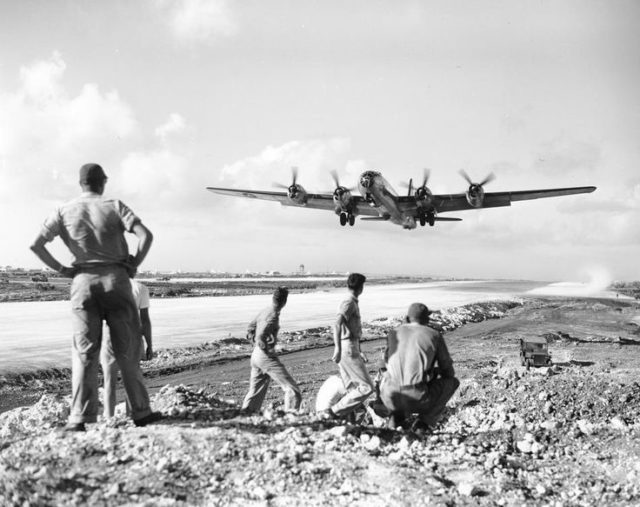
Soon, Boeing developed a more powerful version of the B-29 that was originally equipped with 4 Wright aero-engines of the type R-3350, rated at 2,200 hp per engine. The factory designated the new power boy as the XB-44 with the all new and most powerful piston engines that existed at that time, the Pratt & Whitney Wasp Major Radials R-4360.
This XB-44 flew in May 1945 before the end of the Pacific War. The new monster engines had 4 rows of 7 cylinders each, a total of 28 cylinders in the “corn cob” configuration (see photo below). With 56 spark plugs per engine, a nightmare for a mechanic in case the plugs fouled. The huge 4360 cu in or 71,500 cc displacement per engine reflected also the very end of the development line for the ever bigger Piston aero engines.
Actually, it was the arrival of the very fast but in limited series built German Messerschmitt Me-262 interceptor/ fighter that heralded the new Jet Age. (See photo at end of this Blog) Before the Jet engine came to a widespread application in the post-war era, the aviation industry entered a transition period between 1945 and 1955 in which the Turbojet and Turboprop engines matured steadily toward such high thrust outputs and reliability that they finally could push the huge radial piston engines out of the market for bigger and faster aircraft.
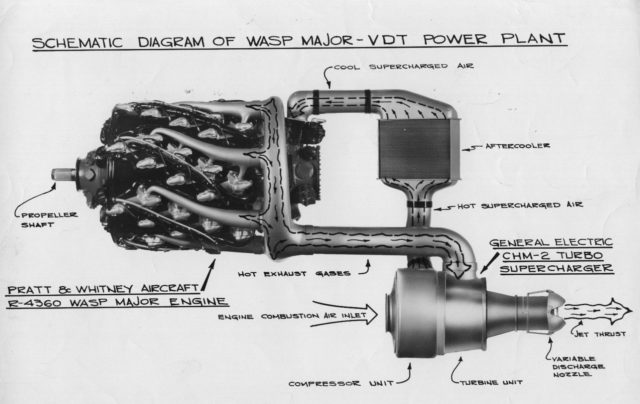
When comparing the ratio cc/ hp for the WWII aero-engines, we see the mid-1930s developed Twin Wasp R-1830 by Pratt & Whitney (World’s most produced radial engine that propelled the Douglas DC-3/ C-47, the PBY Catalina, certain Helicopters and even Sherman Tank types) at max 1,200 hp. But 10 years later, there came this R-4360 with a max output of 3,500-4,300 hp. The cc/hp ratio went from 35-40 hp per liter of displacement to over 50-60 hp per liter.
In the modern automotive industry with much smaller displacements from 1000-3000 cc, a ratio of over 100 hp per liter is the norm by now. In competitions as F-1 and Drag Racing that ratio goes far higher but is due to the (ultra) high stress, only applicable for a short term of engine operations.
Fifty years of large displacement piston engine development, it resulted in an ultra complex engine as the radial R-4360 with a zillion of moving parts and bearings, rods, gears. gaskets etc. all working in extreme conditions under high mechanical and thermal stress. In the case of a failure of one minuscule part, it could stop the gas guzzling monster instantly or worse, make it explode.
She required a lot of maintenance and even with all that hugging, many an R-4360 Wasp Major was prone to in-flight fires and explosions, often due to overheating caused by the very high temperatures of the 100-140 high-octane fuel and the tight engine cowlings of the newer aircraft models that were wind tunnel tested designs, all focused on optimizing the drag factor.
The Wasp Majors R-4360s were produced between 1944 and 1955; 18,697 were built and they were the very last of the huge piston props. That must have been a relief for many a flight engineer or mechanic. But once relegated to the support line in US Military Services, the aircraft with big radial piston aero-engines could survive for many more years.
As the flying tankers (KB/KC-series), personnel/ cargo carriers (MATS), and early warning radar platforms (Lockheed EC-121 Warning Star) that had no frontline or attack duties, the large Piston Props soldiered on into the 1960s and early 1970s.
The KC-97 Stratofreighter tanker and C-97 Transport (based on the B-29 design with similar wings but double flight deck, see ad below) started their careers in 1950 with SAC and the last of the KC-97s flying with the Texas and Utah Air National Guard were phased out in 1978, far into the Jet Age while Jumbo and Concorde already existed for years.
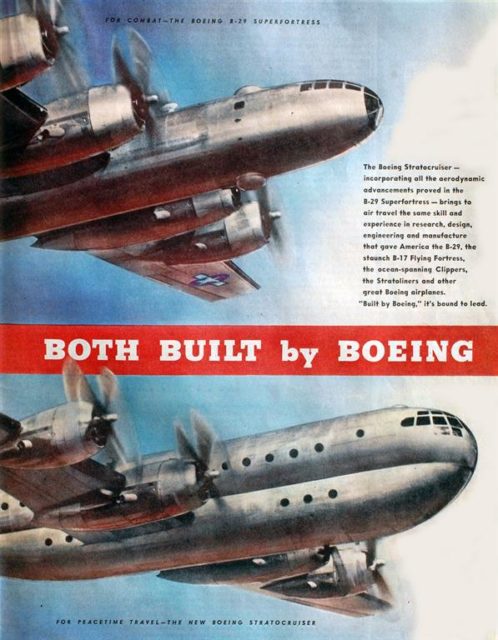
You can read in this Blog about a most interesting development line of the USAF long distance bombers from 1945-1955. A dynamic period of Blitz style technological progress both in (pressurized) aircraft structures and in aero-engine development from “Old School” Piston motors to Hi-tech Jet Technology.
And last but not least in Weapons systems, Electronics, and Radar. The Military aircraft was about to be reinvented by the end of WWII, a Hi-Tech revolution was about to take place with those Jet engines, pressurized cabins, swept wings and electric/ hydraulic flight controls.
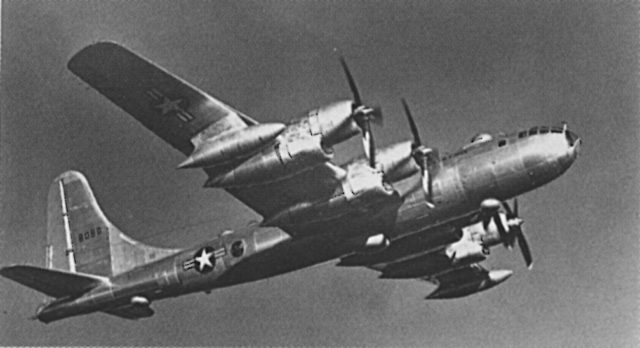
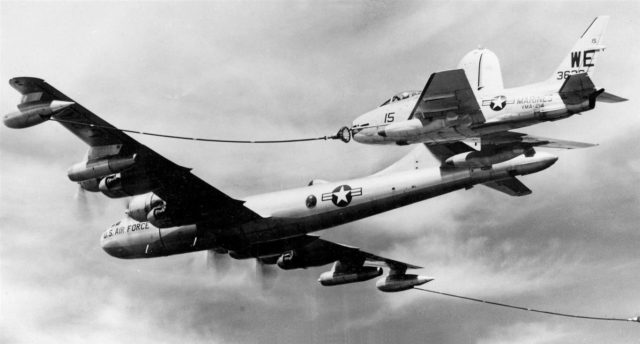
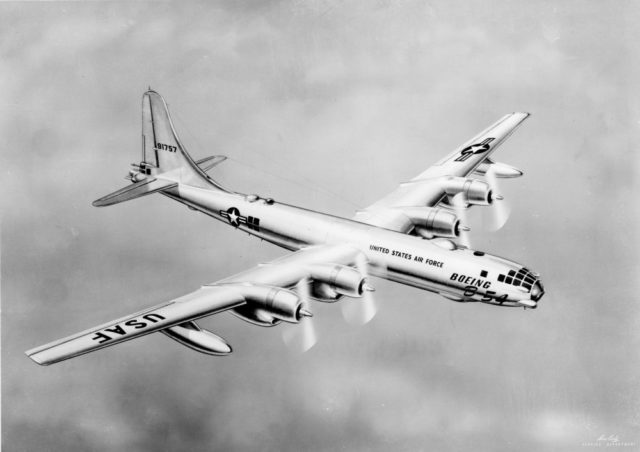
Right after the war, the ‘invited expats from overseas” aka the German Professors, they brought an advanced expertise of their Jet fighters and bombers to the USA. The transfer of their technology was most likely the killer for this seemingly “most modern” but virtually “Old School” bomber B-54. It was USAF General Curtis LeMay who, due to a far-reaching sight (or a good knowledge of that superior technology) had the guts to kill the B-54 project.
That happened at an early stage with only a mockup built of the B-54 (see photos below). Luckily for Boeing, their management was not blind and for acquiring that real cutting edge technology, they could tap the ‘recovered’ German resources as much as the other US manufacturers could.
Soon, they must have found out that the TurboJet engine power in combination with that swept wing concept was the true promise for the future high-speed, high-altitude operating Intercontinental Bombers. In hindsight, you can say that at best, the B-54 would only have been an expensive stop-gap with a limited life cycle of 3-5 years in a decade in which the pace of technological progress was more than awesome.
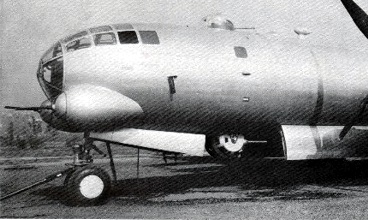
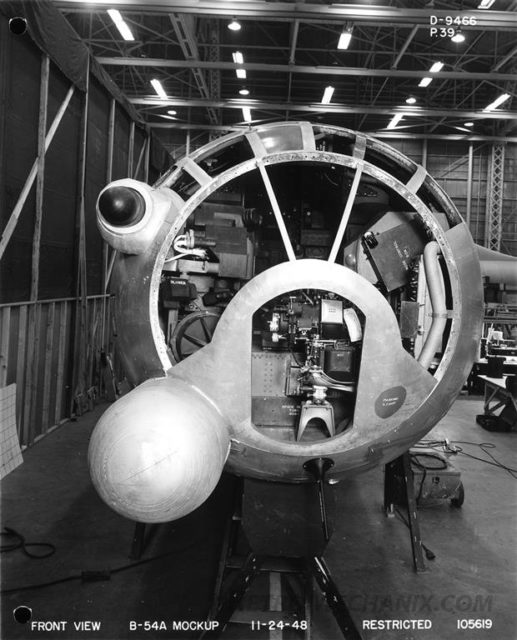
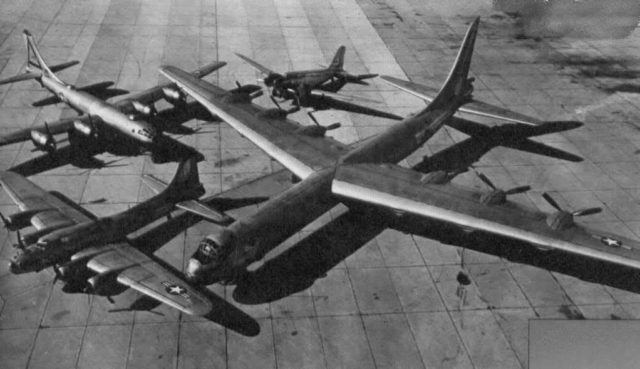
By 1944, the B-29 entered the Pacific war theater and was 3 times bigger than the Bolo. But within only a few years, that B-29 Superfortress was totally overshadowed in size by the Convair B-36 Peacemaker (center right). This strategic bomber was operated by the USAF between 1948-1959. The largest Piston Prop aircraft ever built had the longest wingspan, a whopping 7o m/ 230 ft. With a flight range of 10,000 miles and a max payload of almost 40 tons, it could haul for the Strategic Air Command (SAC) all US Nuclear weapons of that time to any place over the Globe, read including Moscow!
But the B-36 Peacemaker career was also plagued by its six piston engines R-4360s. Hilarious slogans as ” six turning, four burning” soon went over to “two turning, two smoking, and two choking”. The engine problems aggravated, related to the Pusher-Prop configuration of the B-36. In the more standard tractor setup with Props running on the leading edge of the wing, the carburetors in the rear end of the engine receive more heat from the cylinders airflow.
Icing of Carbs in the harsh Alaskan climate often happened and one day in 1950, with 3 engines on fire of a B-36 led to the first in-flight loss of a US owned Nuclear Bomb. Later, Jet pods were added under the wings for more take-off thrust and higher top speed in case of an encounter with an enemy Jet interceptors. Click for more details of that harrowing story my blog here Peacemaker B-36 crashing.
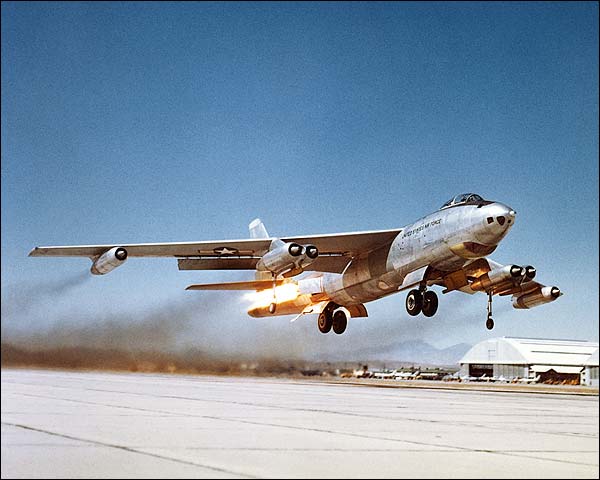
In the B-47 design, only a minimal armament was provided, as its speed and altitude were considered superior to any existing interceptor in the late 1940s. But the bomber’s range was not sufficient to fly independently from Continental USA over the USSR to Moscow. In-flight refueling was the only option but made the bomber more vulnerable.
Worse, the appearance of the Mig-15 Interceptor/ fighter during the Korean conflict (1950-1953) made it clear that even the fast B-47 would never have a chance to accomplish a bomber mission over Russia to Moscow without the escort of long range fighters! But the USA did not have the fighters that could fly such distance at high altitude and high speed. It was a setback that would soon be addressed in the next project, the legendary B-52.
Finally, in the B-52 design, with some help of Luftwaffe technology, the Jet Bomber came to full fruition with its swept wings and full jet propulsion. The canceling of an extended B-29 design in the shape of a B-54 UltraFortress was no longer a frustration. Instead, Boeing got a superb Hi-Tech project in hands that would give them a technological advance for decades in the construction of Big Aeroplanes with Jet engines.
The result of this can be seen in the next photo of the Boeing B-52 and ultimately in the introduction in 1970 of the B-747 wide-body Jumbo Jet of which now over 1,500 have been delivered (ult. 2016).
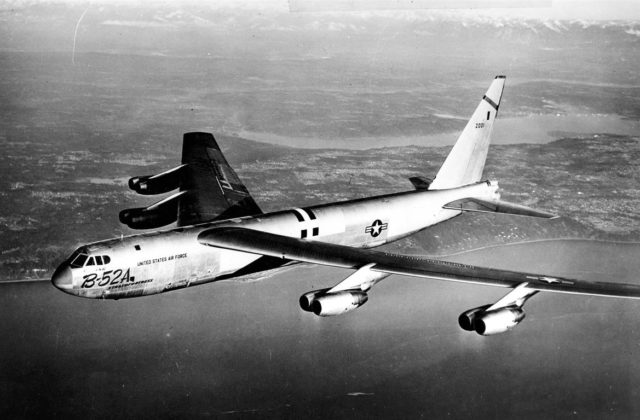
Photo above could be titled: “The Winner takes it all”. It shows the first built Boeing B-52 Stratofortress that came in USAF service in 1955. Now 62 year later, the aircraft is still operational in numbers, 58 B-52H types are in active USAF service, with 18 more in reserve!
The bombers fly under Air Force Global Strike Command (AFGSC) and were reactivated in bombing missions over Afghanistan in 2016, they flew recently to Guam to support the S. Korean defense and over the Baltic Sea supporting the minuscule ex-USSR Republics Latvia and Estonia. Not so bad for an old soldier that fought in Vietnam in the 1960s and many more wars.
With their 70,000 pounds/ 32,000 kg of weapons and a flight range of 8,800 miles/ 14,000 km without in-flight refueling, they still can fly all around the globe, be it not over Russian territory. With their subsonic top speed, they are vulnerable to advanced anti-aircraft missiles. More modern aircraft as the supersonic B-1 Lancer and the Stealth Bomber B-2 Spirit are better adapted for such ultra-secret missions.
Its low operating costs with extremely reliable technology (being upgraded every couple of years with the newest hi-tech), the USAF has saved 76 vintage B-52 aircraft from the cutting torch. Way back in 2006, I saw at Davis-Monthan AFB in Tucson, Arizona, the death row of hundreds of dismantled B-52s waiting for the cutter, but even in 2017, there is still a remarkable number that survived. Moreover, some of them are expected to serve until 2040, another 23 years to go!
The B-52 belongs to that special breed of rare aircraft with a 50+ years career in a continuous service with its original operator or in US Public service. In that league, you can count the members of honor on the fingers of one hand. Next to the B-52, there is the Lockheed C-130 Hercules and its predecessor, the Douglas C-47, and derivated types.
This C-47 is a WWII veteran, built between 1936-1946 in large numbers (over 10,000). Nowadays, some 200 of the DC-3/ C-47 types are still in flying condition or even operational in a commercial role in USA, Alaska, Canada, the Caribbean, Central America and Colombia. Read my Dakota Hunter Blog here: 5 aircraft that served for 50+ years
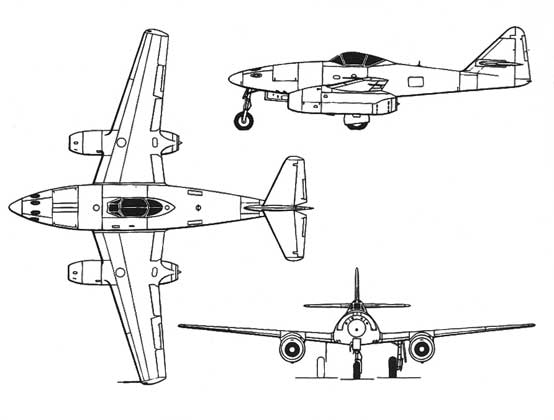
About my 2 books: “The Dakota Hunter” & “Tribute to the Canso/PBY Catalina”:
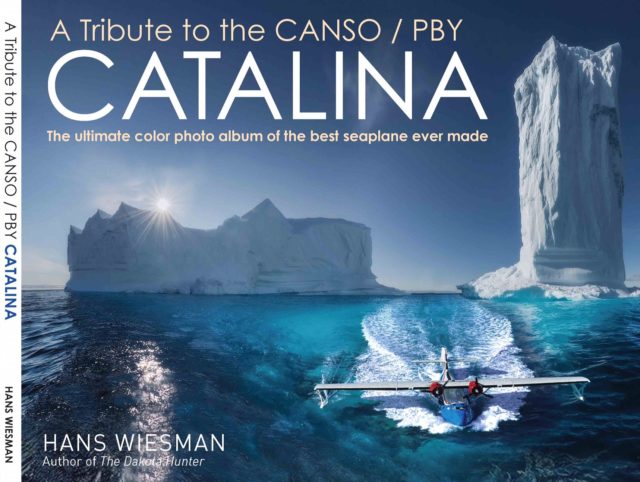
I have a lifetime passion for those WWII transports that must originate from my memorable kid years spent in the Borneo Jungle. I lived there with my Dad, Mom, and family between 1950 -1957. Life was quite different with more challenges and threats than what one would encounter in the civilized Western world. But living out there had a number of highlights of total adventure and thrill as I never met again in my life: encounters with wild animals in our backyard, called Jungle. The creeps came looking for food around our house but found me on their way. I had frequent confrontations with aggressive monkeys, wild boar, giant snakes, spiders, and lizards, just to name a few. Many of them, not impressed by the appearance of a 6/7-year old boy, tried me and quite often, they won the ensuing clashes. But the most impressive encounters I remember so well were with 2 aircraft, both surplus transport planes from the Pacific war that had ended only 5 years earlier. Being our only transport available to fly over the jungle, I flew frequently in the Douglas DC-3 and in the PBY -5A Catalina, owned by Shell Oil Company, my Dad’s employer.
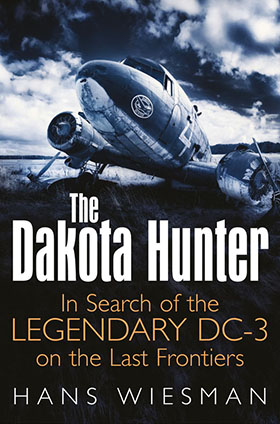
In the mid-1990s, in my professional career as a Creative Director, I met the legendary aircraft again in South America. They were still flying there in numbers, it was an experience as if since 40 years, time was kept in storage in a deep freezer. Their presence mesmerized me profoundly and I decided to go after them as if that could bring back my unforgettable Borneo jungle Playstation time. That was quite impossible but I came close, very close. My hunt for the vintage transports brought me to the remote corners of a forgotten world, in which WWII built aircraft still fly in an operational role.
I was not always welcome as an “extrangero” in the outbacks of the Amazon or Africa. I met the Military, the War Lords and the Drugs and Weapons traffickers who all used the vintage aircraft for their (often illicit) trade. Like the wild animals in the Borneo Jungle so long ago, they tried me and many times, they won and I lost many a deal in the ensuing clashes. But the experience I got over 20+ expeditions around the globe was so overwhelming, that in 2014, I decided to write it all down in a book with 320 pages, jam-packed with the stories of my travels and illustrated with 250 unique photos. Adventurous searches for crashed planes and their parts and harrowing stories of narrow escapes. But also about the very warm and even hilarious encounters. The book got the appropriate title “The Dakota Hunter”, the front cover can be seen below (Publisher Casemate USA/ UK, Philadelphia/ Oxford, 2015).
The book can be ordered at Casemate’s website or at Amazon’s site, where you can read also a dozen of most positive 5-Star reviews from their customers. If interested, please visit this page and scroll down to view other readers opinions. Click here at Amazon Order and Review page The Dakota Hunter.
My new book “a Tribute to the Canso/PBY Catalina” is a unique photo album in landscape format 8.5 x 11 in. With 300 magnificent photos printed in large size (half or full page spreads), this is the ultimate luxury hardcover Lounge Table Book about the iconic Catalina flying boat. A Must-Have for all Aviation Aficionados and for those who appreciate the romance of the Golden Age of the Flying Boats. Soon out (late Spring 2017), you can receive via email a Newsletter and an Early Bird Order-form by subscribing to my Early Bird Mailing list. Click here, view more photos in my Blog post Tribute to the PBY Catalina
For more info about my books and recent blogs, come to my site dc3dakotahunter.com
Enjoy, Hans Wiesman (If interested in my Blogs/ Books, you can follow or friend me on Facebook)